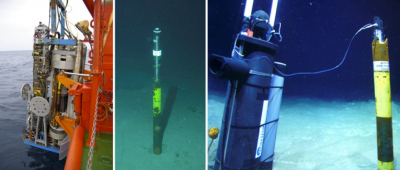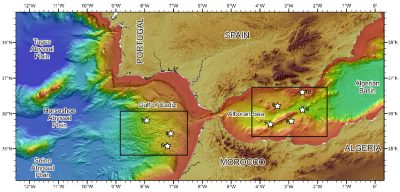- Marine Geotechnics
- Cruises
- Meteor 149
Meteor 149
RV Meteor - Expedition M149
Las Palmas - Cadiz
(25.07 - 24.08.18)
Synopsis
Earthquakes (EQ) and landslides are the most common causes of tsunamis, all of which represent a major threat along the S’ European continental margin. The most crucial knowledge for hazard mitigation is the recurrence intervals of such events in a given region, and the preconditioning factors and triggers that favour the event. The aim of cruise M149 is to study hazards with various triggers: EQ and tsunami deposits as well as fluid seepage sites in the Gulf of Cadiz (i.e. in the area of the Lisbon 1755 event), active tectonics and fluid flow in the W’Alboran Sea (e.g. Carboneras and Al Idrisi Faults) and the plate boundary fault in the Gulf of Cadiz, and landslides along the Portuguese and Spanish margin. Long sediment records using the seafloor drill MeBo and in situ measurements (both during the expedition and as long-term installations thereafter) are pre-requisites for understanding episodicity and risk.
Cruise M149
Scientific Programme
The westernmost portion of the Mediterranean Sea is tectonically complex given the controversial views on the nature and location of the Africa-Eurasia plate boundary and the significance of the Azores-Gibraltar transform fault. At the same time, this region has frequent large magnitude earthquakes with epicentres both on- and offshore, and an instrumental record of seismicity too sketchy for reliable risk assessment or determination of recurrence times in the seismic cycle. This is why expedition M149 sets out to answer two very critical scientific questions:
What do sedimentary records from gravity coring and MeBo drilling reveal about past seismic events?
What are the zones of most active deep-seated fluid flow as a result of deformation in the Atlantic and Alboran sector of the study area?
In order to answer these questions, the scientific programme will include the following approaches:
- Drill across faults
- Drill active mud volcanoes
- Acquire large-scale heat flow profiles over the plate boundary fault system and Gibraltar wedge
- Acquire smaller scale heat flow profiles across mud volcanoes to identify zones of fluid escape
- Instrument selected boreholes with sensors to monitor deformation and fluid flow to study episodic excursions.




